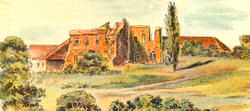History of Moravian Brethern at Neu Sulzfeld
The following history is provided by SGGEE member Cy Harke and is reprinted with permission.
NEU SULZFELD DISTRICT
Neusulzfeld
In 1816, 14 families from the Rheinpfalz region in Prussia immigrated to Poland and established the Neusulzfeld(Nowosoln) congregation. Three families, Christoph Bauer, Schmidt and Schonherr were from Lachen which had a small Moravian congregation. Peter Bauer from Neuwied immigrated a year later. Schaak with his family, from Neustadt a.d. Hardt, Prussia, settled earlier in 1801 and became followers of the Moravian faith. Peter Bauer was the main lay-worker.
After an initial visit to Poland in 1828 by Pastor Karl Domke, the Moravian Directors at Berthelsdorf agreed to establish Diaspora work in Poland in 1829. Domke continued to work in the winter months at the printing shop in Gnadenberg as this was necessary to support himself at home and during his stay in Poland.
In 1837, the Moravian Directors authorized the purchase of land from Christoph Bauer and a residence-prayer-hall was erected under one roof. The prayer-hall could seat 300 and the living quarters had a kitchen, two rooms and a bedroom in the attic.
This was a difficult time for Domke as the 1830 Polish Revolution was rampant with all its bloodshed, misery, sickness and hunger. He was also stricken with typhus which claimed his life in 1840.
Domke's work extended beyond his normal duties of preaching and teaching, e.g Choir Festivals, special services during Easter and Christmas, organizing and directing choirs.
The year 1852 was difficult as a cholera epidemic swept the country; 20,000 died in Warsaw, 40,000 in all of Poland, including several Moravian lay-workers.
In 1847, Pastor Francois Berthoud, a French teacher, was called to establish a boys-school in Poland. After locating a suitable place and after correspondence between Warsaw and Berthelsdorf, Berthoud was informed by the Interior Minister that approval could not be granted. A foreigner is not allowed to establish a school in Poland. Under Berthoud's leadership and drive, a larger church was built in 1869. The parsonage in the prayer-hall was enlarged and two rooms were added. The new church was dedicated by Bishop Friedrich Wilhelm Kuhn who was Director of the department which administered the Russian-Polish work.
In 1862, there was a lay-workers conference at Neusulzfeld. Pastor Ernst Reichel from Berthelsdorf came to Poland for this occasion. A Diaspora Worker Conference was held April 18 and 19, 1873 at Gnadenfrei where the Bohemian work had its roots.
When Pastor Berthoud was serving the Neusulzfeld District, he reported 1700 members and affiliates in 1853 in his district. A total of 18 congregations or assemblies existed in this district at this time.
Pastors serving Neusulzfeld and District were::
1828 - 1840 Pastor Karl Domke( -1840)
1840 - 1841 Pastor Johann Schultz( -1841)
1841 - 1852 Pastor Jeremias Scholz( )
1852 - 1875 Pastor Francois Berthoud( -1905)
1875 - 1876 Pastor Karl Hessemer( )
1876 - 1877 Pastor Fr. Zoberbier( )
1877 - 1895 Pastor Karl Hessemer( -1895)
1895 - 1912 Pastor F. Jordan(1859-1912)
1913 - 1918 Pastor Paul Zucher(1859-1934)
1919 - 1933 Pastor F. Gartner(1868-1957)
1933 - 1935 Pastor H. Kautz(1909- )
1935 - 1938 Pastor E. Hochgeladen(1905-1948)
1939 - 1940 Pastor F. Zaft( )
1941 - 1945 Served from Lodz and Pabianice
Lay-workers in earlier times: Peter Bauer, Schaak
Elders for 1900 to 1945 period: E.Abel, Ad.Roth, P.Abel, R.Himmel, E.Theobald, G.Hoffmann, G.Hauser
TOMASCHOW
This town was visited by Pastor Scholz in the 1840's. A church hall with parsonage was built in 1871. The congregation was served by Pastors from Neusulzfeld. Work ceased here in 1940.
SKORKOWKA
Congregation went through difficult times in WW I when the Germans were banished and not allowed to return until 1920/21. After finding their farmsteads in a delapidated state, some families immigrated to Canada around 1920. A member of the congregation provided a large room in his house and this was used as a prayer hall. Pastors from Neusulzfeld served this congregation. Work ceased here in 1940 when many migrated to the Warthe region.
PABIANICE
Two lay-workers, Benjamin Krusche from Zittau and Neumann from Saganer, organized services and laid the ground-work for a new congregation. A prayer hall was built in 1840.
A new church was built in 1885. Pabianice was split-off from Neusulzfeld and became a separate district in 1895.
Pabianice was a textile with many wealthy members living in good homes. Congregational work was on a sound financial basis. As in other Moravian congregations, the services, special evenings for couples and children's events were attended by many visitors. A major event was the 100th Anniversary of Freedom of Religion in Poland - 1826 to 1926. Bishop Jensen, a Director from Herrnhut, was a key speaker. Massed bands and choirs from other congregations provided the music. Ministers from Lutheran Churches extended greetings.
ZDUNSKA-WOLA
A local textile worker, E. Beutler, organized a meeting with 8 people in 1845 to start an assembly of Moravians. After meeting in private homes for a number of years, a log prayer hall was constructed in 1864. At this time, the congregation consisted of 32 families. During WW I in November 1914, the prayer hall was torched. A new church was erected and dedicated in 1930. The congregation had 123 members at this time. The congregation was served by Pastors from Pabianice.
Lay-workers: Emil Kraeter - earlier times; Julius Henke - later
KALDUNY, PAWLOWO
These congregations, served by Pastors from Pabianice, had their own small prayer-halls.
ZELOW, BELCHATOW
The Moravian lay-workers conducted services in the local Lutheran Churches.
The following Pastors served Pabianice and District:
1892 - 1914 Pastor Karl Uellner(1857-1935)
1914 - 1920 Pastor Hugo Sieborger(1884-1950)
1921 - 1928 Pastor Paul Schmidt(1884-1928)
1924 Teacher-Vicar Hans Preiswerk
1928 Pastors H.Stahelin and A.Raillard
1931 - 1945 Pastor Wilhelm Hildner
Lay-workers: Bosshard, Carl Kolbe, Artur Kolbe, Neumann, Benjamin Krusche
Elders: Artur Kolbe, Reinhold Hegenbart, Adolf Stenzel
LODZ (LITZMANNSTADT)
A church-hall in Lodz was built in 1846. When Bishop W. Kolbing visited Poland in 1901, he concluded that the Lodz congregation had to become self-supporting and have their own minister. The congregation had grown considerably over recent years. The old church was on a plot of land that the city needed so this entailed selling the property and buying a new plot of land. A new church was erected and dedicated in 1913 by Bishop Bourquin from Herrnhut.
Life was difficult and unhealthy in Lodz which had 300,000 residents with no sewage system, no gas, no electricty. Pastor Wunderling's wife was stricken with typhus and needed convalescent care for several months.
At the request of Moravian families living in the forests between the Bug and Pripet marshes in Volhynia, Wunderling made three long visitations in the summers of 1910-1913. Germans settled in this region in the 1800's. Along with special services at each village for several days, he carried out baptisms, weddings, confirmation, etc.
During Pastor Schloss's time in the 1920's, inflation was rampant and life was difficult as the salary was barely sufficient. He could see the need to emphasize Youth Programs. Since lay-workers were the back-bone of congregations, he held Lay-Worker Seminars. More young men with Polish citizenship were needed for training in the Seminary at Herrnhut.
In Jan 1945, the church was taken over by the Catholic Mariawiten.
Pastors serving the Lodz congregation were:
Earlier period: Served by Pastors from Neusulzfeld
1903 - 1906 Pastor Sam. Raillard(1869-1945)
1907 - 1918 Pastor Paul Wunderling(1873-1939)
1919 Pastor F. Gartner
1922 - 1925 Pastor Erwin Schloss(1894-1955)
1925 - 1932 Pastor Hans Preiswerk(1900- )
1932 - 1934 Pastor Emanuel Schiewe(1900-1964)
1933 Assistant - Pastor W. Zwick
1935 - 1945 Pastor Hugo Kautz
Lay-workers: Hofaker, Gerok
Elders: Albert Hausmann, Richard Hausmann, Julius Grunwald, Gustav Neumann, Willy Wahl
KONSTANTYNOW
A small church-hall was built in 1868 on a plot of land donated by Adolf Wegner. A band was organized in 1884. Olga Kuhn from Lodz took charge of children's services.
The congregation had their own Pastor for a while in earlier times. Later, when the town was linked to Lodz by a street car, it was served by a Pastor from Lodz. Pastor E. Hochgeladen moved to this location from 1938 to 1940 to carry on with his monthly publication and Evangelistic work.


